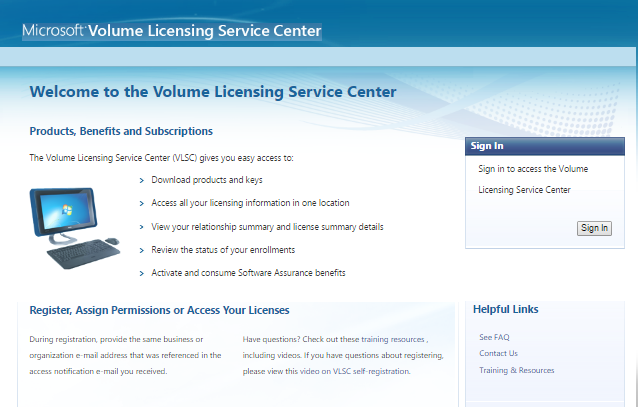How to Migrate Your Microsoft Volume Licensing Service Center (VLSC) User Account
If you are a Microsoft Volume Licensing customer, you may have noticed a change in the way you log in to the VLSC site. Starting from September 3, 2021, you will need to use a Work or School Account (WSA) to access the VLSC site and manage your software licenses. This change is part of Microsoft’s effort to enhance the security and privacy of its users.
In this article, we will explain what VLSC is, why you need to migrate your user account to a WSA, and how to do it step by step.
What Is Microsoft Volume Licensing Service Center (VLSC)?
Microsoft Volume Licensing Service Center (VLSC) is an online tool that allows you to manage your Microsoft Volume Licensing agreements and software downloads. You can use VLSC to:
- View and activate your product keys
- Download or order installation media
- Access your benefits and subscriptions
- Manage your users and permissions
- Get support and resources
To access VLSC, you need to have a valid user account and an active Volume Licensing agreement.

Why Do You Need to Migrate Your VLSC User Account to a Work or School Account (WSA)?
A Work or School Account (WSA) is an account that is owned and managed by an organization and is used to access Microsoft services, including VLSC. A WSA typically takes the form of username@orgname.com or username@orgname.onmicrosoft.com (where orgname is the employer’s domain name). This format helps customers and Microsoft alike in confirming that a user’s assigned permissions are accurately and securely affiliated with the licensed organization.
Migrating your VLSC user account to a WSA provides several benefits, such as:
- Increased security and privacy: A WSA is protected by multi-factor authentication and encryption, which means that only authorized users can access the account and the data associated with it. A WSA also complies with the General Data Protection Regulation (GDPR) and other privacy laws.
- Single sign-on: A WSA allows you to access multiple Microsoft services with a single set of credentials. You don’t need to remember multiple passwords or switch between accounts.
- Simplified management: A WSA is easier to manage than a Microsoft account (MSA), formerly known as a Live account, or unmanaged tenant accounts. A WSA is owned and managed by an organization, which means that the organization can control access to the account and the data associated with it. The organization can also assign roles and permissions to different users, monitor their activity, and revoke their access if needed.
How to Migrate Your VLSC User Account to a Work or School Account (WSA)
The process of migrating your VLSC user account to a WSA is quick and easy. To help make this transition easier, here are three scenarios for this migration:
- Scenario 1: If you are a first-time user of VLSC and don’t have a WSA, sign in as a “brand new user” or inherit permissions from an existing MSA. You will be prompted to create a new WSA or use one provided by your organization. Follow the instructions on the screen to complete the migration.
- Scenario 2: If you have previously signed in to VLSC using an MSA, you can sign in with this existing MSA up to five times before you must use or create a WSA for continued access to the tool. After five attempts, you will be prompted to create a new WSA or use one provided by your organization. Follow the instructions on the screen to complete the migration.
- Scenario 3: If you are an existing Azure Active Directory (AAD) user, sign in with a WSA and follow the AAD sign-in experience. Internal admin takeover of the Azure Directory might be necessary in this scenario.
After you migrate your VLSC user account to a WSA, you will be able to access the VLSC site and manage your software licenses as usual.
Conclusion
Microsoft Volume Licensing Service Center (VLSC) is an online tool that allows you to manage your Microsoft Volume Licensing agreements and software downloads. To improve the security and privacy of its users, Microsoft has migrated VLSC users to Work or School Accounts (WSAs). WSAs offer increased security, single sign-on, and simplified management for VLSC users. To migrate your VLSC user account to a WSA, follow the instructions on the screen when you log in to the VLSC site. If you have any questions or issues, please contact SCHNEIDER IT MANAGEMENT for free expert consultancy on your Microsoft licensing.
Links
To sign in into the Microsoft Volume License Service Center (VLSC), please visit: https://www.microsoft.com/licensing/servicecenter/default.aspx
For more information and in-depth instructions on this, please refer to this resource document: https://docs.microsoft.com/en-us/azure/active-directory/enterprise-users/domains-admin-takeover.
If a user currently doesn’t have any purchased Online Services, it’s possible for them to sign up for a free WSA. In that case, please visit: https://signup.microsoft.com/Signup?offerid=8339cc50-d965-4ad5-bb94-749021a5ebf9&origin=azurequote&ali=1&Country=US&ru=https://admin.microsoft.com.
Did you find this information useful? Subscribe to our newsletter: https://www.schneider.im/newsletter/ and be up-to-date with all software licensing changes!
Please contact us for more information and for help on your WSA migration.
FAQs
What is the Microsoft Volume License Service Center (VLSC)?
The VLSC is an online tool for managing Microsoft Volume Licensing agreements and software downloads.
Why is Microsoft migrating VLSC users to Work or School Accounts (WSAs)?
Migrating to WSAs provides greater security and simplified user management for VLSC users.
What are the benefits of using a WSA for VLSC?
WSAs offer improved security, multi-factor authentication, and centralized user management.
How do I migrate my VLSC user account to a WSA?
VLSC users will be prompted to create or use a WSA to log in to the VLSC site. The process is quick and easy, and Microsoft provides three migration scenarios to help users make the transition.
What happens if I don’t convert my VLSC user ID to a Work or School Account?
After a limited number of attempts to sign in using your existing credentials, such as a Microsoft account (MSA), formerly known as a Live account, or unmanaged tenant accounts, the only way to continue to access the site will be through a WSA.
What happens to my existing VLSC account information when I convert to a Work or School Account?
Your existing VLSC account information will be migrated to your new Work or School Account.
Do I need to create a new Work or School Account if I already have an Office 365 account?
No. If you already have an Office 365 account, you can use that account to sign in to the VLSC site.
What if my organization doesn’t have a domain name?
If your organization doesn’t have a domain name, you can create a tenant domain name in Microsoft 365 admin center.


